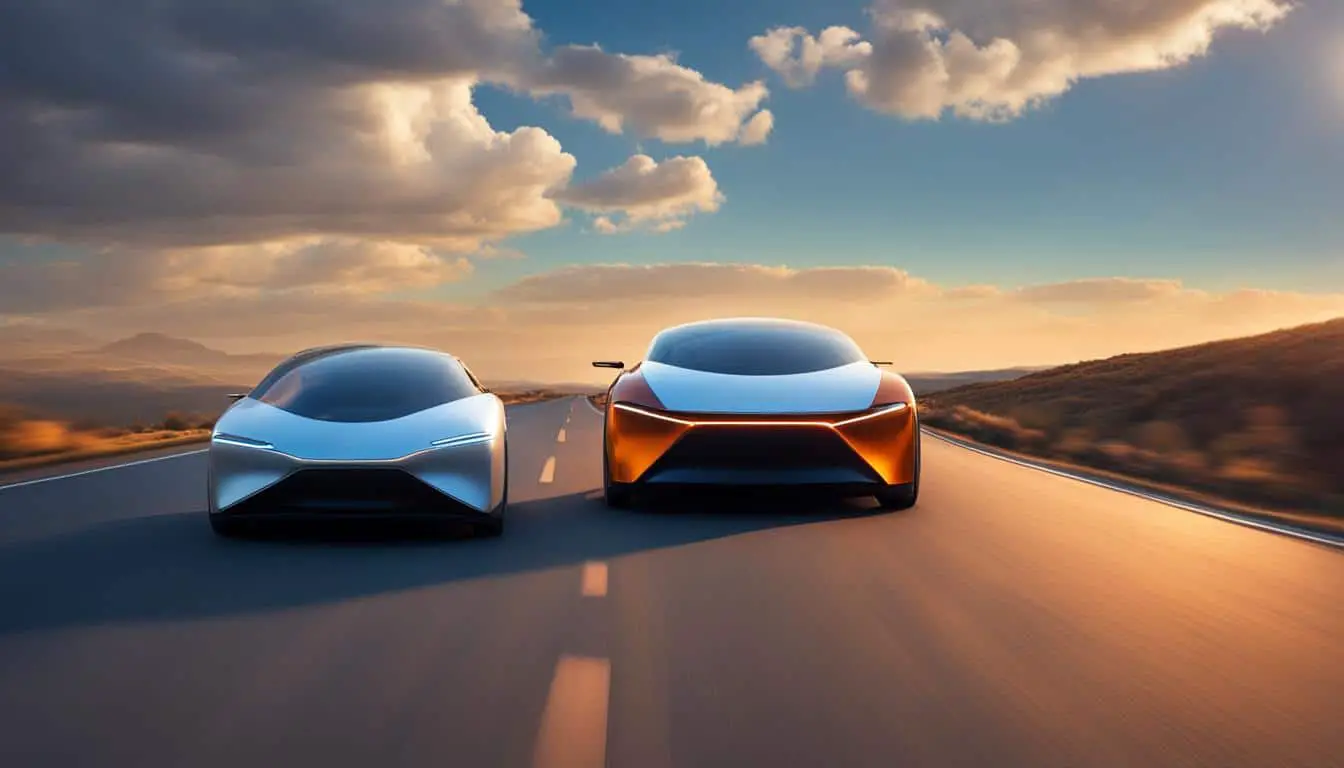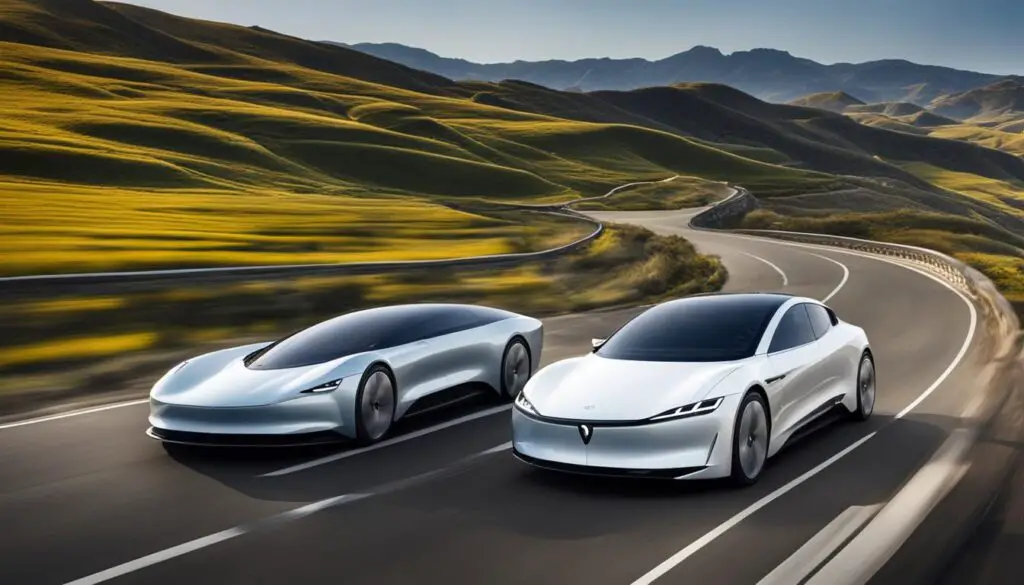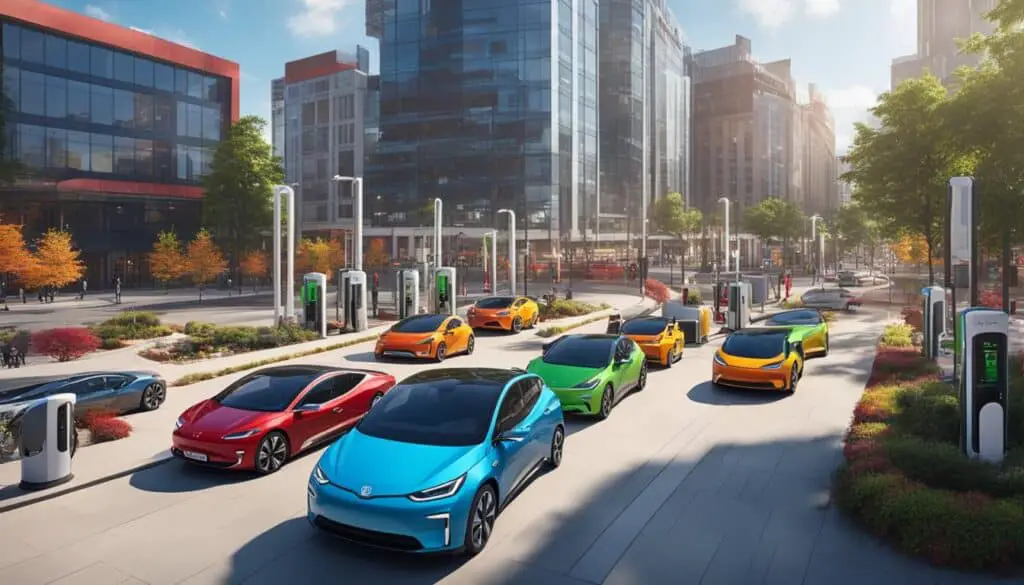
Range Comparison: Electric Vehicles vs. Gasoline Cars
As the adoption of electric vehicles (EVs) continues to grow, many potential buyers still have concerns about the range capabilities of these vehicles. Known as “range anxiety,” this worry stems from the fear of running out of battery power before reaching the desired destination. In this article, I will compare the range of electric cars to that of traditional gasoline cars, providing insights into the current state of EV range and its implications for prospective buyers.
Key Takeaways:
- EV adoption has increased in recent years, but range anxiety remains a top concern for many prospective buyers.
- The average range of electric cars has significantly improved over the last decade, reaching 217 miles on a single charge in 2021.
- Gasoline cars still offer longer ranges, with the median gas car range in the U.S. being around 413 miles in 2021.
- Factors such as temperature, operating conditions, and driving speed can affect the range of electric vehicles.
- Several long-range electric car models are available in the U.S., with continuous advancements in battery technology expected to bridge the range gap.
Factors Affecting EV Ranges
While EV ranges depend on battery capacity and motor efficiency in theory, real-world results can be influenced by several factors. These factors include:
- Weather Impact on EV Range: Temperature plays a significant role in determining the range of an electric vehicle. In colder temperatures below 20℉ (-6.7℃), EVs can experience a range loss of around 12%. This range loss can increase to 41% if the heating system is turned on inside the vehicle.
- Operating Conditions: The operating conditions of an EV can also affect its range. For example, regenerative braking, which allows the vehicle to recover and store energy during deceleration, can result in extended range during city driving.
- Speed Impact on EV Range: Driving at high speeds can lead to a loss of range in electric vehicles. This is because higher speeds cause the EV motor to spin faster, resulting in less efficiency and increased energy consumption.
On the other hand, driving at optimal temperatures of around 70℉ (21.5℃) can actually exceed the rated range of an EV, as the battery performs more efficiently under these conditions.
It’s important to note that EV ranges can vary depending on external conditions and individual driving habits. Therefore, it’s crucial for EV owners to consider these factors when planning their trips and managing their range expectations.
Top Long-Range Electric Cars in the U.S.
The U.S. market offers several electric car models with impressive ranges. According to Environmental Protection Agency (EPA) range estimates, the top 10 longest-range electric cars available in the U.S. as of 2022 are:
| Electric Car Model | Range (miles) |
|---|---|
| Tesla Model S Long Range | 405 |
| Tesla Model S Plaid | 390 |
| Tesla Model 3 Long Range | 353 |
| Tesla Model X Long Range | 341 |
| Tesla Model Y Long Range | 326 |
| Lucid Air Dream Edition | 520 |
| Porsche Taycan Turbo S | 315 |
| Audi e-tron GT RS | 238 |
| Jaguar I-PACE EV400 AWD | 234 |
| Ford Mustang Mach-E GT | 232 |

Addressing Common Concerns about EVs
Despite the growing popularity of electric vehicles (EVs), misconceptions and concerns about their viability still persist among consumers. Let’s address some of the common concerns surrounding EVs:
Misconception: EVs are not affordable
One major misconception about EVs is that they are expensive and out of reach for most consumers. While it’s true that some luxury electric models have higher price tags, there are also more affordable options available in the market. In fact, EV prices have been steadily decreasing over the years, and with government incentives and tax credits, the upfront cost of an EV can be more manageable than you might think.
Misconception: EVs lack performance
Another misconception is that EVs lack the power and performance of traditional gasoline cars. However, EV technology has come a long way, and many electric models now offer impressive acceleration and torque. The instantaneous torque delivery of electric motors provides a thrilling driving experience, and some EVs can even outperform their gas-powered counterparts in terms of acceleration.
Misconception: EVs have limited range and range anxiety
Range anxiety, the fear of running out of battery power and being stranded, is a common concern among potential EV buyers. While it’s true that EVs typically have a shorter range compared to gasoline cars, advancements in battery technology have significantly increased the average range of electric models. Most electric cars now offer ranges that can comfortably cover daily commuting and regular driving needs. Additionally, a reliable charging infrastructure is rapidly expanding, making it easier than ever to find a charging station when needed.
Misconception: EV charging infrastructure is insufficient
Concerns about the availability and convenience of charging infrastructure are understandable, but the reality is that the EV charging network continues to expand at a rapid pace. There are already thousands of public charging stations across the country, and various businesses and government entities are investing heavily in building more infrastructure. Additionally, many EV owners choose to install charging stations in their homes, providing convenient access to charging overnight or whenever needed.
“Misconceptions about EVs often stem from outdated information. The truth is that EV affordability, performance, and charging infrastructure have seen significant improvements, making them viable options for a wide range of consumers.”
By addressing these common misconceptions, we can shed light on the true benefits and advantages of electric vehicles. The EV industry continues to evolve, and it’s essential to stay informed and consider the latest advancements when making a decision about your next car.

Conclusion
When comparing electric vehicles (EVs) to traditional gasoline cars, range is a crucial factor to consider. Over the years, EV ranges have seen significant improvements. The average battery-powered EV can now travel 217 miles on a single charge. However, it’s important to note that gas-powered cars still offer longer ranges.
But the good news is that advancements in battery technology are continuously being made, and new EV models are being rolled out. These developments are expected to further narrow the range gap between EVs and gas cars. As a result, the future looks promising for EV range improvements.
Furthermore, addressing common misconceptions about EVs is essential in helping potential buyers make informed decisions. Concerns about affordability, performance, and charging infrastructure often deter individuals from considering EVs. By debunking these misconceptions and providing accurate information, we can encourage more people to explore the benefits of electric vehicles.
As the EV market continues to evolve, it is crucial for consumers to consider their individual driving needs and preferences. Range is just one aspect to consider, alongside factors like affordability, performance, and charging infrastructure. By taking these factors into account, potential buyers can make well-informed decisions when comparing and choosing between electric and gasoline cars.
FAQ
How does the range of electric vehicles compare to that of gasoline cars?
Electric vehicles (EVs) have made significant improvements in range over the years, with the average battery-powered EV now able to travel 217 miles on a single charge. However, gas-powered cars still offer longer ranges, with the median gas car range in the U.S. being around 413 miles in 2021.
What factors can affect the range of an electric vehicle?
Several factors can influence the range of an electric vehicle. Temperature plays a significant role, as EVs can lose around 12% of their range at temperatures below 20℉ (-6.7℃), with the range loss rising to 41% if heating is turned on inside the vehicle. Operating conditions also impact range, with regenerative braking allowing for extended range during city driving. Driving at high speeds can result in range loss, as EV motors spin faster at a less efficient rate. On the other hand, driving at optimal temperatures of about 70℉ (21.5℃) can actually exceed the rated range of an EV.
What are the top long-range electric cars available in the U.S.?
According to Environmental Protection Agency (EPA) range estimates, some of the longest-range electric cars available in the U.S. as of 2022 include models like the Tesla Model S, Lucid Air, Ford Mustang Mach-E, Chevrolet Bolt EUV, and Audi e-tron GT, among others.
What are some common concerns and misconceptions about electric vehicles?
Some common concerns and misconceptions about electric vehicles include affordability, performance, and charging infrastructure. However, as technology advances and more EV models enter the market, these concerns are being addressed. Electric vehicles are becoming more affordable, performance is improving, and the charging infrastructure is expanding to accommodate the growing demand for EVs.
How should I consider range when comparing electric vehicles to traditional gasoline cars?
Range is an important factor to consider when comparing electric vehicles to traditional gasoline cars. While EV ranges have significantly improved over the years, gas-powered cars still offer longer ranges. However, advancements in battery technology and the continuous rollout of new EV models are expected to further bridge this gap. It’s essential to consider individual driving needs and preferences when making a comparison and choosing between electric and gasoline cars.
